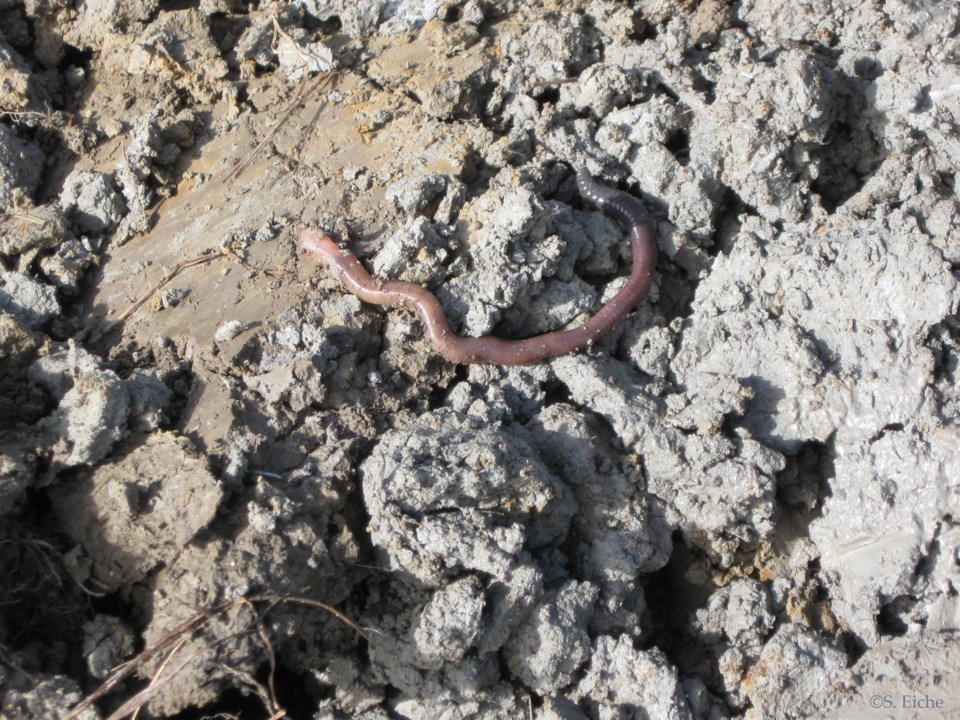Until a couple of years ago I would have said earthworms held no surprises for me. Then three things happened that did surprise me. First, I witnessed something I’d never seen before – two earthworms lying on the ground, side by side as if glued together. I thought (in all innocence) that they were locked in combat. Second, this past summer, as I was digging in hard, dry soil, I came across several pink earthworms curled up in a kind of intricate knot. They were alive, but I couldn’t imagine what they were doing. Finally, a knowledgeable friend explained that the earthworms wriggling through our soil were non-native. I almost didn’t believe him.
What could I do but begin investigating? To my amazement, Richmond Public Library had only one adult non-fiction book on earthworms (Sally Coulthard, The Book of the Earthworm) and Vancouver Public Library had three, but both had many children’s books on the subject. Next, I went on the internet where I found several sites, popular as well as academic, about earthworms. The popular sites were often confusing and contradictory. The academic sites were scientific and technical, though even these were often far from clear.
But I did manage to find enough information to explain the three things that had surprised me. Let’s begin with some basic information, since not everyone has looked as closely at an earthworm as they have at, say, a bird.
The earthworm, an invertebrate (meaning no backbone), is composed of segments, which extend and retract, allowing it to move, mostly forward. Each segment has eight tiny retractable hairs (setae) to help movement. The head end of the earthworm has a mouth (prostomium) to grab food, which is stored in the crop. From there the food goes to the gizzard, where it’s ground up with bits of soil and tiny stones. After passing through the intestine it exits at the tail end (anus) as castings.
Near the head end of the earthworm is a band, distinguished by a slightly different colour. Called the clitellum, it contains the reproductive apparatus. Although earthworms are hermaphrodites, that is both male and female, they cannot fertilize their own eggs and thus need another earthworm to supply the sperm.
What I was witnessing on the ground in my yard was not two earthworms in combat but two earthworms engaged in reproduction. While mating they lie side by side, head to tail. The clitellum of each becomes enveloped in a slime tube. As the earthworms move out of the slime tubes, the tubes pick up the eggs and the sperm.
When the earthworms have slipped all the way out of their slime tubes, the eggs will have been fertilized. The slime tubes then close to form a cocoon. In about two weeks the eggs hatch into wormlings. It takes them two more weeks to grow into juveniles. Depending on the species and environmental conditions, a juvenile earthworm takes anywhere from a month and a half to nearly a year to become an adult and sexually mature (indicated by the presence of the clitellum). Earthworms can live between four to eight years, if no harm befalls them.
Before I move on to my second surprise, I should mention that, based on their burrowing habits, earthworms are divided into three main types: epigeic, endogeic and anecic. The epigeic earthworm lives on or near the surface of the soil, feeding on leaf litter; the endogenic type burrows horizontally and finds nourishment in the mineral soil, beneath the leaf litter; the anecic earthworm burrows vertically (as far down as one metre), coming to the surface to feed on leaf litter.
The earthworms I saw curled up into an intricate knot inside rock-hard clods, at a depth of about 10 centimetres, were actually seeking refuge from the heat and drought. They were in a state called estivation (dormancy during hot, dry periods), waiting for the soil conditions to become more hospitable for their requirements.
We consider earthworms a normal (and desirable) component of our gardens, which left me shocked to hear that they were not native, and in some situations even considered invasive.
Here’s what happened. During the last ice age, glaciers moved southwards covering what would eventually become Canada, and also areas corresponding to some of the northern states. As the glaciers moved south, they pushed away the top soil with whatever life was in it, including worms. The ice age ended about 11,700 years ago. The forests that grew in the newly recovered land developed as worm-free ecosystems. When Europeans began to settle in North America, nearly three centuries ago, they brought plants and soil with them from back home. The earthworms in our backyards are native to Europe, not Canada. While they are essential to our gardens, they also change the soil environment of boreal forests by speeding up the break-down process of organic material. This danger has become intensified in recent years by the arrival of Asian jumping worms, which are larger and recycle organic matter even faster. Earthworms on their own travel slowly – about five metres a year – but they have made their way into previously worm-free territory thanks to the activity of humans.
While investigating my "surprises," I’ve gained an extra bit of knowledge about earthworms. It’s made me want to protect and help them even more than I did before.
Sabine Eiche is a local writer and art historian with a PhD from Princeton University. She is passionately involved in preserving the environment and protecting nature. Her columns deal with a broad range of topics and often include the history (etymology) of words in order to shed extra light on the subject.



